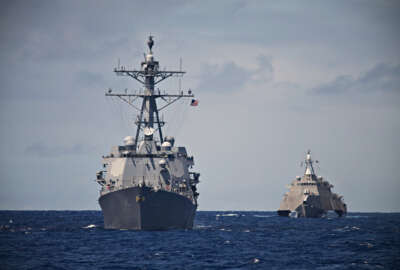Insight by Akamai
DoD Cloud Exchange 2023: Akamai’s Dave Zukowski on ‘competing together’ to achieve zero trust
Given zero trust’s multiple pillars, players and tech elements, Akamai Defense’s Dave Zukowski suggests intense governance can help ensure collaboration and...
The Pentagon and the Biden administration have set clear goals for what zero trust cybersecurity should look like across federal networks.
But with successful implementation of zero trust spread across seven pillars, it’s important to recognize where the Defense Department is making the most progress, said Dave Zukowski, director of defense solutions at Akamai Defense.
“The progress this year has been mostly on the understanding side. What all the department has started to realize is, ‘We’ve got a lot of the foundational underpinnings already in place. We’ve got stuff we’ve been doing. We’re starting to understand what the tenets are of zero trust,’ ” Zukowski said during Federal News Network’s DoD Cloud Exchange 2023.
While DoD is laying out a common set of zero trust goals for its service branches to achieve, Zukowski noted that the services are competing for limited funds to make implementation a reality.
Why collaboration makes sense
“Structurally, they have to get to a point where we can compete, but we should be competing together. We should be competing to fight the enemy not necessarily ourselves,” he said.
That cooperation is critical to ensure the military services aren’t duplicating efforts to reach zero trust compliance.
“Because zero trust is a holistic architecture, we’ve got teams in place that are working on one part of it. But in order for their part to work, they’re relying on three or four other parts,” Zukowksi said. “Rather than work with a team that’s doing those three or four other parts, they start building them out themselves. What we end up with is some pretty significant overlap.”
To drive continued growth toward DoD’s zero trust goals, Zukowksi said the department should set clear benchmarks.
“Measurement, in general, drives behavior, and I think if we’re not careful, we’re going to drive the wrong behavior,” he said. “If we’re measuring the Department of the Army, or the Department of the Air Force, at the top level of their maturity toward zero trust, without understanding their roadmap, we could look and see, ‘Well, 99 out of your 100 networks are nowhere near compliant.’ ”
Zukowski said those types of metrics focused on DoD’s legacy networks will lead to spending too much time “to fix what we already know is broke” and detract from the bigger picture of migrating the department’s networks to a less trusted and more monitored environment.
“DoD as a whole is working on doing measurements. … They very specifically don’t want to drive the wrong behavior, but I think they need to understand the architectural roadmaps more and that each department is going to measure themselves differently,” he said. “That difference is going to matter greatly when you start rolling up these metrics. We’ve got to understand how they want to measure themselves.”
Cloud One leads by example on zero trust
Zukowksi pointed to the Air Force’s Cloud One project as a case study on how to successfully implement zero trust.
“Cloud One was designed from the ground up to be zero trust–ready,” he said. “They used all the tenets of zero trust to build and design it and start migrating applications.”
The Air Force ensured the success of these efforts by making centralized funding available for its component offices to move to the cloud.
“Part of that was to say, ‘Hey system owner, we know you don’t have the funding to both operate your current environment, maintain your software updates for your current systems, and now we’re asking you to migrate to the cloud,’ ” Zukowski said. “These programs now had a big carrot: We can get to the cloud, and somebody else is going to pay for it. Part of that carrot was, if you’re going to come to the cloud, you’re going to follow these enterprise rules. There’s going to be ruthless governance at the top.”
To read or watch other sessions on demand, go to our 2023 DoD Cloud Exchange event page.
Copyright © 2024 Federal News Network. All rights reserved. This website is not intended for users located within the European Economic Area.
Related Stories
Featured speakers
-

Dave Zukowski
Director, Defense Solutions, Akamai Defense
-

Jory Heckman
Reporter, Federal News Network
On DoD
Upcoming Events
Related Stories
Top Stories

Dave Zukowski
Director, Defense Solutions, Akamai Defense
Dave brings over 24 years of experience working with DoD Information Technology. Dave currently serves as a Principal Technical Consultant for Akamai’s public sector, supporting USAF, Army and others. Dave is responsible for helping these agencies in their broad IT missions and operations while also educating them on the effective use of the Akamai portfolio while on their cyber security and Zero Trust journeys. Dave is an experienced enterprise architect that helps these agencies sew together the diversity of their portfolios to bring seamless and secure digital delivery for their consumers.
Prior to joining Akamai in 2019, Dave was a Principal Engineer for the MITRE Corporation and while there was the primary Enterprise Architect in charge of designing a multi-cloud enterprise hosting environment for the USAF currently known as Cloud One. Dave’s role was to bring together the diverse architects and engineers of multiple corporate entities and drive a collaborative and scalable solution for multi-tenant, secure, cloud delivery.
Prior to that Dave was the CTO of IPT Associates providing direct software engineering and architectural support to numerous organizations primarily within the USAF. Dave’s passion is supporting to the Department of Defense in their mission supporting the American Public, he is a veteran of the USAF and spent his time there as an enlisted software engineer.
Mr. Zukowski has an AAS in Computer Science from the Community College of the USAF, a BS in Information Technology and an MBA with an IT Management concentration from the University of Massachusetts Lowell. Dave also holds a CSSLP from ISC2.

Jory Heckman
Reporter, Federal News Network
Jory Heckman has been a reporter at Federal News Network since January 2018. Jory got his start as an intern in 2011 and was a digital news writer and editor for Federal News Network from 2014 to 2018. He also worked as a desk assistant with CBS News Radio in New York and was a reporter for the Citizens’ Voice newspaper in Wilkes-Barre, Pennsylvania.







